Uplifting Depressions
I've arrived at a wonderful place. That is, I've written so many Joy o' Kanji essays that they are starting to overlap thematically.
This could be confusing, I suppose, because just when I have it in my head that one kanji means X, I discover that another character represents something quite similar. However, that's not a new idea. After all, kanji study often involves knowing which characters are interchangeable and when.
Mostly, I feel excited that some essays have related content. It's as if I'm assembling a 2,136-piece jigsaw puzzle and have found two pieces that lock together with a satisfying snap. That leads me to think that I'm making a dent in the nearly infinite task I've set for myself.
Speaking of dents, that's exactly where today's essay overlaps with two previous ones:
essay 1032 on 凹 (concave, hollow; sunken), which is brand-new
essay 1156 on 虚 (void, vacant; false, falsehood; futile)
essay 1987 on 臼 (mortar; millstone; hand mill)
As you can see from their definitions, these kanji are certainly distinct. As I wrote each essay, I rarely encountered the other two kanji. However, they can all refer to physical depressions, pits, hollows, and, yes, dents.
It suddenly seems to me that hollows and depressions are everywhere. When I take trails through the woods and pass through urban areas, I spot hollows in trees and large pits in boulders. Last week I lost control on a Southern California beach, taking photo after photo of rocks with perfect divots.
Seeing this theme all around me has spurred me to review the two older essays (1156 and 1987) to see where they overlap and diverge with 1032. I've now had a look-see and have pulled out some of the most salient points of intersection.
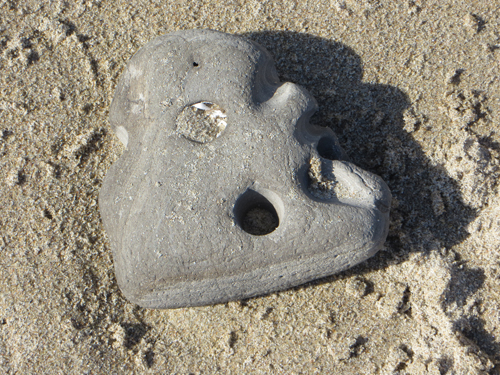
Photo Credit: Eve Kushner
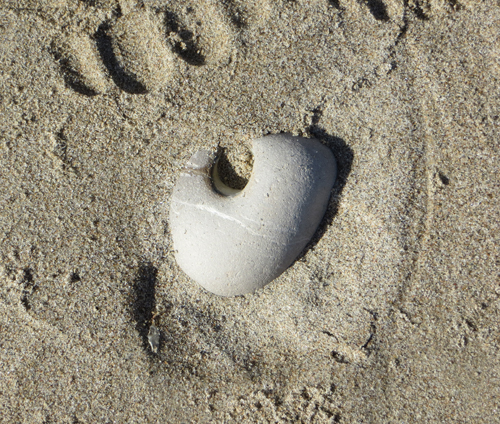
Photo Credit: Eve Kushner
A Hollow in a Tree
The second definition of 凹 is "hollow," as in the following terms:
穴ぼこ or 穴凹 (あなぼこ: (1) hole; a hollow; (2) pothole) hole + depression
窪地 or くぼ地 or 凹地 (くぼち: pit; a hollow; (land) basin; depression (in land))
a hollow + land
It seems obvious to me that 凹 would also be the way to refer to a hollow in a tree, but no, that's not right! Instead, we can use 虚 for that:
木の虚 (きのうろ: hollow of a tree) tree + hollow
The bottom part of 虚 originally represented “hill with a hollow crown,” such as an extinct volcano, says Henshall. Even now, he notes, 虚 can mean “hollow” in the sense of Sleepy Hollow or “dip in the ground.” Mostly, though, people use 虚 to refer to hollow words or hollow promises. That is, it primarily conveys falseness and dishonesty. Who would have thought, then, that 虚 would be the key kanji for expressing "hollow in a tree"?
My proofreader reminds me that 洞 can also mean “hollow (in a tree)” and mentions this term as another possibility:
樹洞 (じゅどう: hollow in a tree) tree + hollow
Oh, I included that in essay 1661 on 洞 (cave; tunnel; hole; to see through). How could I have forgotten about that kanji amid all this talk of hollowness?! In a discussion of non-Joyo yomi for 洞, one sidebar in that essay presents the following listings from Breen:
虚; 空; 洞 (うろ; うつお; うつほ: hollow; cavity; hole)
虚ろ; 空ろ; 洞ろ (うつろ: blank; cavity; hollow; empty (space))
The text continues this way:
Three kanji clearly have overlapping meanings: 洞, 虚, and 空. All three can mean “hollow; cavity; hole.” All three convey that something is missing or empty.
Furthermore, 虚 and 空 share the kun-yomi of むなしい (empty, void; vain, futile; dead, lifeless).
However, these characters have distinct differences; 空 primarily means “sky” and “air,” and although 虚 mainly means “void,” it has strong connotations of “false front” or “sham.” When it means “empty,” it’s in the sense of “empty of meaning” or “lacking in substance.” ...
When 洞 means “hollow,” by contrast, there’s nothing as complex as that. There’s no fraud, no ripoff. It doesn’t represent anything more than, say, the hollow of an old tree.
As long as I'm doing a round-up, I'll mention that essay 1467 on 杉 (cedar) has a bit about a hole in a tree. It's located at a shrine in Nikko (Tochigi Prefecture on Honshu), and if you make a wish while facing the hollow in that tree, your wish will supposedly come true.

Photo Credit: Eve Kushner
I took my Thanksgiving guests for a walk along my favorite trail in the woods.
They enjoyed talking to each other through an enormous tunnel-like hollow in a tree.
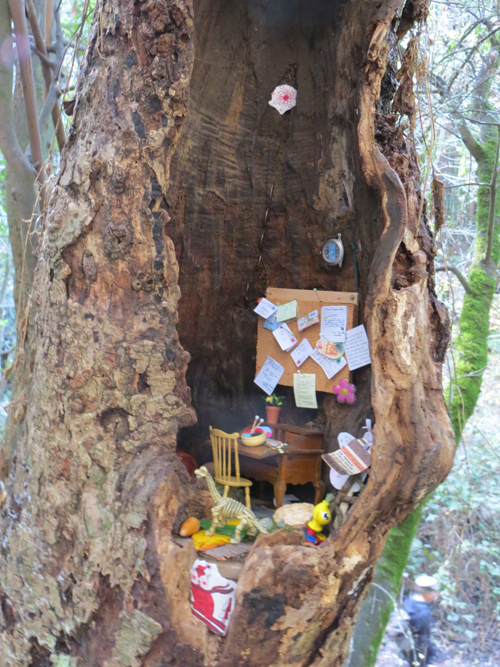
Photo Credit: Eve Kushner
On an adjoining trail someone has fancifully decorated another hollow in a tree.
Mortars
Essay 1032 on 凹 has just one section on mortars, but I think that's my favorite part. It concerns a book with 3-D maps of Tokyo’s hilly topography. Here's the subtitle:
「東京『スリバチ』地形散歩」
Walking Tokyo’s “Suribachi” Topography
東京 (とうきょう: Tokyo); スリバチ (earthenware mortar with a rough interior); 地形 (ちけい: topography); 散歩 (さんぽ: walk)
To understand this, you need to know that a スリバチ (すり鉢) is a small earthenware mortar that usually takes the form of a bowl. Its largely unglazed interior has grooves that provide a cutting surface. The Japanese imported the suribachi from China in about 1000 CE, initially using it to crush herbs for medicine and now using it to crush sesame seeds and the like when preparing food.
What an ingenious leap to compare Tokyo’s up-and-down topography to the interior of this kind of grooved bowl!
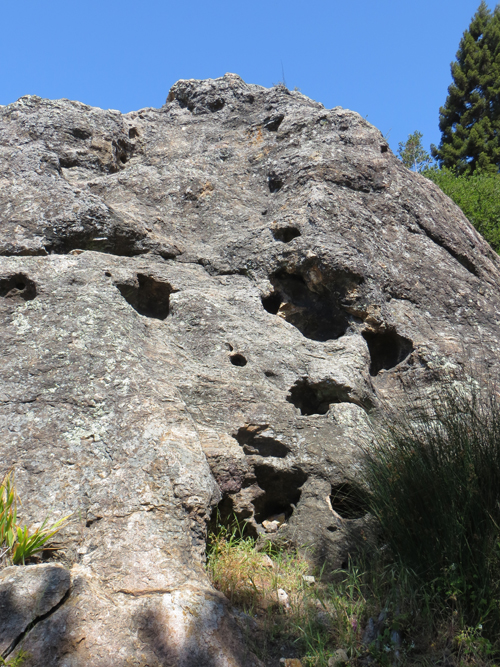
Photo Credit: Eve Kushner
A boulder in my neighborhood.
U-Shaped Depressions
Essay 1987 on 臼 focuses quite a bit on mortars, of course. It would be strange if that weren't the case! As I browsed through it just now, this word jumped out at me:
脱臼 (だっきゅう: dislocation) to get out of place + socket (of a joint)
I explained in the essay that 臼 can mean “socket (of a joint)” in Chinese. I also said the following:
Musing about how 臼 came to represent “socket,” I commented to my proofreader that perhaps it’s because there can be grinding inside a joint. He thought that was possible but provided a more obvious explanation; 臼, he said, can represent things with a U-shaped depression, including a socket.
A U-shaped depression?! Well, that's what 凹 is about from the get-go! I mean, it's a pictograph of concavity! The difference is that it's typical for 凹 to mean "U-shaped depression" and rare for 臼 to do so.
Be that as it may, I found more examples of 臼 as a "U-shaped depression" in essay 1987, such as this term:
臼砲 (きゅうほう: mortar cannon) mortar + cannon
I wrote there that “mortar” in English can mean both "bowl for grinding with a pestle" and "stocky cannon," among other things. As it happens, 臼 can represent each of these definitions. That's no coincidence. It came about because both a bowl and a cannon are receptacles of a sort; that is, they have U-shaped depressions.
Here's one more discovery from 1987 that I just love: We all have our own personal mortars conveniently located in our bodies. These objects with small depressions are perfect for grinding. You may be most familiar with them as molars:
臼歯 (きゅうし or うすば: molar) mortar + tooth
That just never stops seeming cool to me!
And So?
I'm not sure what grand conclusions to draw from all this pattern matching. Perhaps there are no big, bold statements to make. The point of it all—of this particular discussion and of kanji immersion in general—is to bounce from one thrilling discovery to another, simply because the aha moments make life so much richer.
I think you'll find many such moments in essay 1032 on 凹:
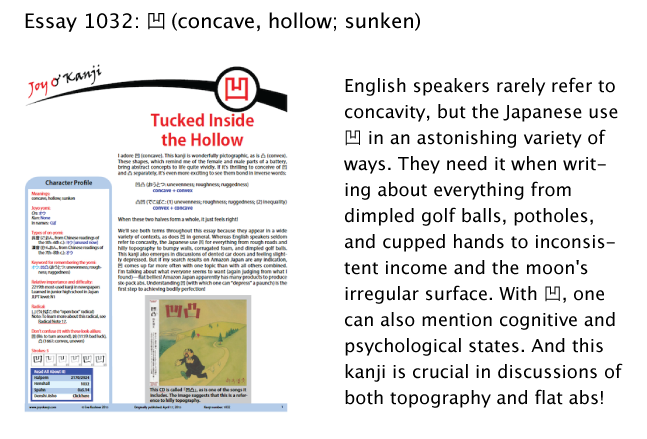
However, if you're holding out for a sweeping pronouncement, here's my best effort: Life is like a big suribachi with endless ups and downs. I hope you stay on top of those grooves all weekend! (I guess that would make it truly groovy!)

Comments